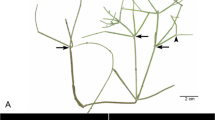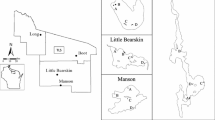Abstract
Eurasian water milfoil (Myriophyllum spicatum L.) declined significantly in Chesapeake Bay from 1965 to 1967. This decline generally exceeded 95%, and was associated with several pathologic conditions, previously named Northeast disease and Lake Venice disease. We believe that these pathologic conditions have been responsible for the decline. No study of Lake Venice condition has yet been undertaken, but this paper presents evidence that Northeast condition is an infectious disease. Northeast disease symptoms can be transmitted in the laboratory by a bacteriologically sterile filtrate passed through a 0.2 μ filter. This indicates a virus, virus-like particle, or a toxin as the etiologic agent. The primary pathogen is probably a virus, and the evidence for this will be presented in a later paper. Gram-negative bacilli obtained from diseased milfoil probably represent secondary infections.
In September 1967, diseased milfoil showed a resurgence of growth and successfully flowered in several areas of the Bay. This may represent the development of genetic resistance to the pathogen, or it may be a natural cyclic pattern with reduced virulence of the pathogen. In November 1967, however, milfoil in Middle River collapsed to a greater extent than expected from normal winter kill, and that remaining was in very poor condition.
Similar content being viewed by others
Literature Cited
Anderson, R. R. 1964. Ecology and mineral nutrition ofMyriophyllum spicatum L. M.S. Thesis. University of Maryland, College Park, Md.
Bawden, F. C. 1964. Plant viruses and virus diseases. 4th Ed. Ronald Press, New York, 361 p.
Elser, Harold J. 1966. Status of aquatic weed problems in tidewater Maryland, Spring, 1966. Mimeo rept., Manatee Project, Annapolis, p. 1–9.
Elser, Harold J. 1967. Observations on the decline of milfoil and other aquatic plants in Maryland 1962–67. Mimeo. Rept. prepared for the 1968 Annual Meeting of the Weed Science Society, New Orleans, La. 15 p.
Patten, B. C., Jr. 1954.Myriophyllum spicatum L. in Lake Musconetcong, New Jersey: Its ecology and biology with a view toward control. M.S. Thesis, Rutgers University, New Brunswick, N. J.
Ward, R. W., V. Vreeland, C. H. Southwick, andA. J. Reading. 1964. Ecological studies related to plankton productivity in two Chesapeake Bay estuaries. Chesapeake Sci., 6(4):214–225.
Author information
Authors and Affiliations
Additional information
Supported by Contract 3-56-R-1 with Maryland Department of Chesapeake Bay Affairs and U. S. Bureau of Commercial Fisheries with funds from the Commercial Fisheries and Development Act of 1964, P. L. 88–309.
Rights and permissions
About this article
Cite this article
Bayley, S., Rabin, H. & Southwick, C.H. Recent decline in the distribution and abundance of Eurasian milfoil in Chesapeake Bay. Chesapeake Science 9, 173–181 (1968). https://doi.org/10.2307/1351183
Issue Date:
DOI: https://doi.org/10.2307/1351183




